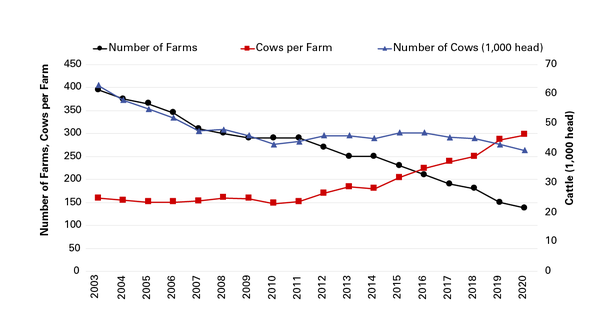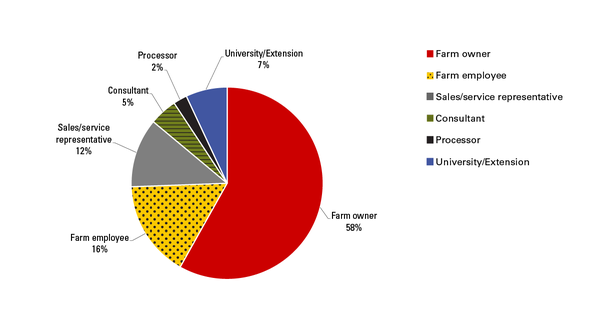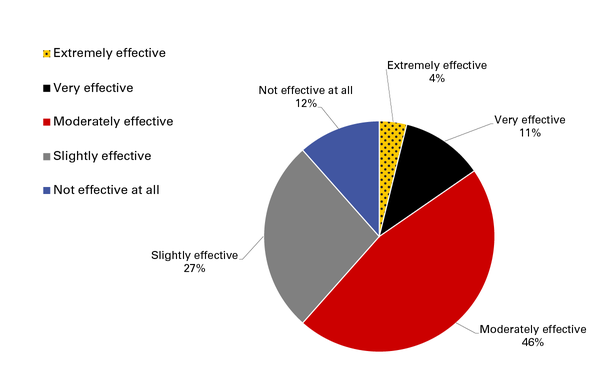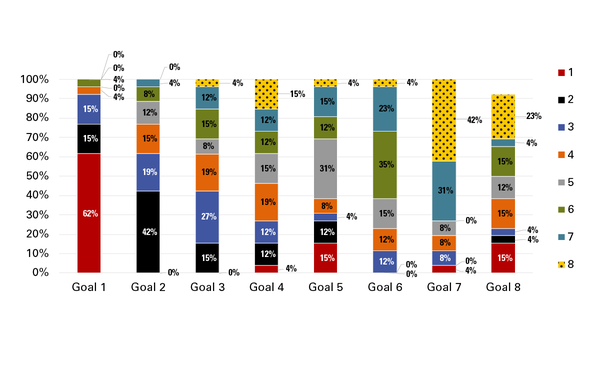Summary
In 2003, North Carolina was home to more than 60,000 dairy cows and 400 dairy farms. In 2020, there were just over 40,000 cows and 138 Grade A permitted dairy farms (Figure 1). The average farm size has increased from roughly 150 cow herds in 2003 to just under 300 cow herds in early 2020. These numbers reflect national trends in which the total number of cows has remained static, but the total number of farms has decreased while the average size has increased, indicating a large consolidation in the industry. This change in the industry necessitated an assessment of dairy support organizations to determine if they are achieving their stated goals in the current environment in North Carolina. Three organizations whose primary role is supporting the dairy industry (not including youth development programming) were evaluated: NC Dairy Advantage (NCDAV), NC Dairy Producers Association (NCDPA), and the dairy related programs within NC State Extension. An electronic questionnaire was used to evaluate producer and industry stakeholder perceptions of these three organizations and how effectively the respective organizations are meeting stated goals. The questionnaire also sought to determine what farmers and other stakeholders regarded as the most serious challenges and opportunities for the North Carolina dairy industry, and what they believed were critical needs for research and extension programming as the industry continues to change.
Extension has changed dramatically over time in terms of expectations from the industry and needed programmatic efforts. Historically, both campus-based and county Extension personnel were able to be more “hands-on” in terms of providing service to dairy farmers, but that has changed with a decrease in the number of faculty and county personnel focused specifically on dairy in recent decades. NCDPA, a membership organization established in 1996, was designed to represent dairy farmers in areas where neither NC State Extension nor NCDAV may act, such as in policy development and legislative advocacy. NCDAV, an educational nonprofit organization, was established in 2007 in response to the decrease in dairy-focused Extension, as well as to boost farmer and stakeholder efforts to strengthen dairy support programs across the state and beyond. One primary goal for NCDAV was to grow existing dairy businesses and recruit new dairy businesses to North Carolina. With dwindling numbers of dairy farms and volatile markets, recruitment of new business is not an easy task, so efforts within NCDAV may be better focused on other goals.
Methods
The 17-item questionnaire, created using Qualtrics®, was distributed through farmer/stakeholder email lists and also posted on social media accounts targeting the North Carolina dairy industry. The responses were anonymous, and no demographic information other than industry affiliation (See NC Dairy Stakeholder Survey, Q1) was collected. The survey was available for completion for 15 days. A total of 49 responses were received; 32 surveys were answered completely. Completed answers from 17 partial responses were included in the summary of data, where applicable. Questions were designed to determine the most critical issues facing the industry, to identify needed research and Extension topics, and to gather feedback on how the organizations could be more effective. Open-ended questions (7) were asked to provide flexibility for respondents. Answers to those questions were categorized by the authors, based on the recurrence of common terms or themes within the written responses. The same approach was taken for questions in which written answers were given for “other” options. Ranking questions (3) required respondents to rank the importance of stated goals for each organization. To rate items (4), a 5-point Likert scale was used (1 = extremely effective; 5 = not effective at all). Multiple choice (3) questions asked respondents to provide basic demographic data. Data are reported as means, modes, and frequencies.
Survey Results
Nearly 75% of the respondents identified themselves as either a farm owner or employee, resulting in a 26% farmer response rate. The next largest groups represented were sales/service representatives; consultants; University/Extension; and processors, respectively (Figure 2).
Identification of Challenges, Opportunities, and Research/Outreach Areas
Low milk prices and high input costs were reported as the primary challenges for the North Carolina dairy industry, followed closely by issues associated with processing and marketing of milk (Table 1). More specific responses about challenges, grouped by the authors in “Low milk process, high input costs, profitability,” include increased milk hauling costs, marketing fees, and milk quality discounts. All of these mean less money in the farmers’ paychecks. This survey also identified “negative consumer opinions about dairy production” and the “decreased consumption of fluid milk” as major threats to the North Carolina dairy industry.
|
Category |
Frequency |
|
Low milk prices, high input costs, profitability |
19 |
|
Milk marketing (including balancing costs), decreased fluid milk consumption/demand, and outdated policy |
16 |
|
Negative public perception and/or urbanization pressures |
7 |
|
Labor |
5 |
|
Infrastructure |
3 |
When asked about opportunities for growth and improvement (Table 2), respondents identified “value-added and/or ‘local’ markets” and “diversification of farm income” as the top opportunities, which the authors grouped as the name of the category. A significant number of respondents indicated a lack of opportunity in the current dairy climate with no hope for improvements on the horizon. With equal weight, “robotics/technology,” “improved marketing,” and “innovative product development” were also identified as opportunities for North Carolina. Likewise, “consumer preferences” and “product development” were also listed as the top areas of necessary research, followed by “herd health” topics, and “milk quality” (Table 3).
|
Category |
Frequency |
|
Value-added, "local," diversification on-farm (i.e., agritourism) |
9 |
|
No opportunities |
6 |
|
Technology (robotics), increased efficiencies |
5 |
|
Connecting with consumers on animal welfare, nutrition, positive public relations |
5 |
|
Prices/marketing |
5 |
|
Processing/innovation (large and small scale) |
2 |
|
North Carolina's climate/agricultural economy/infrastructure supportive of agriculture |
1 |
|
Category |
Frequency |
|
Consumer preferences/product innovation |
10 |
|
Herd health (mastitis, calf care, reproduction, transition management) |
9 |
|
Milk quality |
7 |
|
Cow cooling/heat abatement |
5 |
|
Feed alternatives |
5 |
|
Economics/technology |
4 |
|
Manure/environment |
2 |
|
Animal welfare |
1 |
Effectiveness of Current Dairy Organizations and Support Programs
In the survey, participants evaluated how effectively NC State Extension, NCDPA, and NCDAV meet their respective organizational goals and how to better define the impact of each of these organizations. While each has different objectives and goals relative to the industry, they all have a mission to serve dairy farms and dairy farmers in the state. However, the shrinking number of dairy farms in North Carolina calls into question whether these organizations can continue to function effectively as originally intended. Fewer producers are available each year to serve in necessary leadership roles, and the rapid speed of decline in farm numbers the industry is experiencing means the organizations serving them must adapt to remain relevant.
NC State Extension Dairy Team
The general goals of NC State Extension are to:
- Identify local needs and challenges
- Collaborate with specialists to find potential answers
- Transfer research-based knowledge to North Carolinians
- Translate knowledge into practical applications
- Improve the economy
- Enhance residents’ quality of life
Figure 3 shows how effectively respondents felt that the NC State Extension dairy team met the goals of NC State Extension. Overall, the NC State Extension dairy team was rated as moderately to very effective (mean = 2.8; mode = 3). “Identify local needs and challenges” and “Collaborate with specialists to find potential answers” were ranked very to extremely effective by 44% and 67% of respondents, respectively. “Transfer research-based knowledge to North Carolinians” and “Translate knowledge into practical solutions” were ranked moderately to very effective by 70% and 67% of respondents, respectively. Respondents indicated that the NC State Extension dairy team was moderately effective in being able to “Improve the economy” and “enhance citizens’ quality of life.”
When asked how NC State Extension could better serve the North Carolina dairy industry, respondents cited timing and location(s) of meetings or trainings. Specific suggestions included having evening meetings, as many farmers are not able to leave the farm during working hours as readily as they have done in the past because of decreased labor availability. While some respondents suggested large, regional meetings, others requested direct on-farm and face-to-face contact. Producers also noted that their preferred method of receiving information from NC State Extension is through half-day or 1-day workshops. Video or other interactive trainings and online/web-based materials were preferred next. Mailed hard copies were the least popular method of receiving information.
NCDPA Effectiveness
Overall, the NCDPA was considered to be moderately effective (mean = 3.0; mode = 3) at achieving its mission “to ensure the future presence of profitable and viable dairy farms in North Carolina” (Figure 4). In terms of achieving its stated goals and demonstrated priority of those goals, survey respondents ranked “Provide a unified voice for dairy producers on issues that affect them” first, followed by “Serve as a means for dairy producers to respond to public interest/concerns to maintain good public relations” (Table 4). Although these two goals were ranked as most important, NCDPA was perceived as being effective at achieving only the first one. Goals with the lowest reported priority for the organization included “Maintain positive dialogue with other agricultural organizations to support common concerns” and “Maintain communication with milk marketing groups, cooperate to ensure efficiency marketing and optimum milk pricing.”
|
NC Dairy Producers Association Goals |
Rank of Importance |
|
Provide a unified voice for dairy producers on issues that affect them. |
1 |
|
Serve as a means for dairy producers to respond to public interest/concerns to maintain good public relations |
2 |
|
Support educational activities to keep dairy farmers informed of public issues and to determine solutions |
3 |
|
Communicate the economic importance of dairy production to the general economy |
4 |
|
Support educational activities to inform the public on the source of milk and dairy products and their dietary importance |
5 |
|
Cooperate with local, state, and federal agencies in advancing the best principles of agriculture as it relates to dairy |
6 |
|
Maintain positive dialogue with other agricultural organizations to support common concerns |
7 |
|
Maintain communication with milk marketing groups, cooperate to ensure efficient marketing and optimum milk pricing |
8 |
|
Other1 |
|
|
1Specific comments collected under “Other” include: “Promote economic impact”; “Providing good care to animals and land”; “Healthy product from dairy farms”; and “Be an industry liaison.” |
|
When asked how NCDPA could be more effective, the comments were categorized as follows:
- Make the organization better known to farmers and other stakeholders to increase engagement.
- Increase communication within and external to NCDPA.
- Increase the focus on policy and marketing.
Producers also indicated that their preferred method for receiving information from dairy organizations (NCDPA and NCDAV) is email newsletter. Social media posts and hard copy of printed materials were ranked very low.
NCDAV Effectiveness
Overall, survey respondents considered NCDAV as somewhat to moderately effective (mean = 3.4, mode = 3) at achieving its mission, “To sustain and grow the North Carolina dairy industry” (Figure 5). “Enhance the value of milk and dairy products produced in North Carolina” and “Support the numbers of dairy farms in North Carolina” were ranked the two most important goals of NCDAV, and “Increase the volume of Grade A milk production” was ranked as least important to survey respondents (Table 5).
|
NC Dairy Advantage Goals |
Rank of Importance |
|
Enhance the value of milk and dairy products produced in North Carolina |
1 |
|
Support the numbers of dairy farms in North Carolina |
2 |
|
Enhance dairy farm family quality of life |
3 |
|
Increase the volume of Grade A milk production |
4 |
|
Other1 |
|
|
1Specific comments collected under “Other” included: “Increase farm income”; “Increase the price paid to dairy farmers”; and “Teach how to feed high forage rations for lower feed costs and greater milk component production.” |
|
When asked how NCDAV could be more effective for the North Carolina dairy industry, responses ranged from “Quit beating a dead horse” to “increasing public education” and “helping farmers focus on profitability.” One comment indicated “the need to reconsider what growing the North Carolina dairy industry may look like going forward from 2019.”
Comments from respondents have provided great insight into the needs of dairy farmers and the roles that NC State Extension, NCDPA, and NCDAV should play in the industry. NCDAV seemed to have greater name recognition among respondents than NCDPA. Respondents did not feel that NCDAV is as effective as NCDPA in meeting its mission and goals.
Both NCDPA and NCDAV had only one of their stated goals (respectively) that was ranked as high priority by the majority of respondents. For NCDPA, that goal was to “Provide a unified voice for dairy producers on issues that affect them” (Figure 6). But, for NCDAV, the highest ranked goal was to “To enhance the value of milk and dairy products produced in North Carolina.” (Figure 7).
For NCDPA, only three of its eight stated goals were consistently ranked in the top three by at least 30% of respondents. Those include (in order): “Provide a unified voice for dairy producers on issues that affect them”; “Serve as a means for dairy producers to respond to public interest/concerns to maintain good public relations”; and “Support educational activities to keep farmers informed of public issues and to determine solutions.” “Maintain communication with milk marketing groups, cooperate to ensure efficient marketing and optimum milk pricing” was ranked as a top priority by 15% of respondents, but it fell behind the previously mentioned goals for the majority of respondents. For NCDAV, one additional goal was ranked a top priority for at least 30% of respondents: “Support the number of dairy farms in North Carolina.” All others were ranked as lower priority goals.
The majority of farm owner and farm employee respondents indicated a willingness to serve on a board of directors (60% or 14 responses) and/or a committee (66% or 15 responses), while only 43% (9 responses) were interested in serving in a leadership role. This may reflect a willingness to fill a required position but a reluctance to take on additional responsibilities associated with leadership in those positions, which is a common organizational challenge. A reduction in the number of dairy farms since the inception of NCDPA and NCDAV has reduced the number of dairy farmers who are eligible to fill board and committee positions necessary to fulfill the bylaws requirements of each separate organization. Consequently, the NCDPA Board of Directors voted to amend its bylaws in 2019 to reduce the required number of board members from 15 to 9, reflective of this result. The shrinking pool of candidates available to fill these positions has led to a greater burden on those dairy farmers who agree to serve these organizations; the same few people commit to multiple roles, which contributes to volunteer and leadership fatigue. Perhaps reduced labor availability on the farm, combined with the need to diversify income via off-farm employment, means that meaningful participation by board and committee members has decreased.
Conclusions and Implications
The results of the survey confirmed assumptions about challenges, opportunities, and research needs for the North Carolina dairy industry. Given that nearly 75% of respondents were either dairy farm owners or employees and that since 2014, prices in the dairy industry have been at a historical low, the responses related to profitability, milk marketing, and cash flow on the monthly milk check were expected. The responses related to identifying opportunities were diverse, ranging from a stated desire for alternative marketing options (for example, value-added) to a desire for increased knowledge of technology and the potential it holds for sustainability of the industry. The focus on public perception and consumer opinion of the dairy industry was timely; multiple examples of negative coverage of dairy farming have pervaded social and the general media.
Ensuring that our goals as Extension personnel match with the actual needs of industry stakeholders is critical, so these results were very useful in that regard. Given that NCDPA has eight stated goals and NCDAV has four, and of those twelve combined, respondents ranked only three or four (respective of the organization) of them as top priorities, perhaps each organization needs to consolidate priorities. Coupled with the decreased number of people willing or able to serve in leadership roles, a merger of these organizations could make them more effective.
Publication date: May 25, 2021
AG-900
N.C. Cooperative Extension prohibits discrimination and harassment regardless of age, color, disability, family and marital status, gender identity, national origin, political beliefs, race, religion, sex (including pregnancy), sexual orientation and veteran status.







